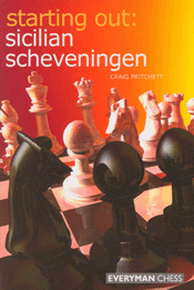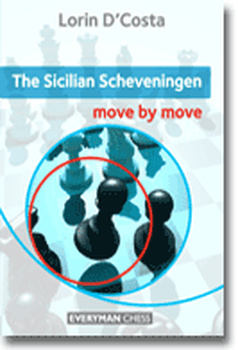| Nivå | B-D |
| Utgivelsesdato | Mars 2012 |
| Forfatter | |
| Pris | 255 NOK |
The Sicilian Scheveningen move by move
Everymans nye seriesuksess fortsetter med svarts mest klassiske sicilianer: Scheveningen med e6 og d6. Her brukes også denne trekkrekkefølgen som tillater Keres-angrepet 6 g4.
Forfatteren IM D'Costa har ellers Kasparovs behandling av systemene som mye av et forbilde i boka, og supplert med en del enda nyere partier. Basisstillingen for boka oppstår etter trekkene 1 e4 c5 2 Sf3 e6 3 d4 cxc4 4 Sxd4 Sf6 5 Sc3 d6, og så behandles de mange fortsettelsene og dermed litt ulike stilllingstypene som hvit kan fortsette med.
Konseptet i boka er det svært pedagogiske og verbale i denne åpningsbok-serien "Move by Move", som engasjerer leseren mer direkte i prosessen gjennom mange spørsmål og svar.
Forfatterens introduksjon
Welcome dear reader! You’ve started by opening the book at the start (unless you’ve first skipped to later chapters, and are referring back to the beginning to wonder what on earth is going on), so there is no better time than the present to introduce the Sicilian Scheveningen: 1 e4 c5 2 Nf3 e6 3 d4 cxd4 4 Nxd4 Nf6 5 Nc3 d6
So why is it called the ‘Sicilian Scheveningen’? Well, it was first played by Max Euwe in the Scheveningen tournament of 1923 in his home country of the Netherlands, against two of the best players of that era, Maroczy and Spielmann. As with many chess openings, it was named after the place where it was first played, but it could just have easily been called the ‘Euwe Sicilian’ or something similar. However, we will let Max Euwe off, for he was later to get his glory by winning the World Championship title from Alexander Alekhine in 1935.
Now we come to the critical part: why should you pick the Scheveningen Variation, instead of one of the other supposedly more popular Sicilians such as the Najdorf or Dragon? Few of us are interested in spending good time and money travelling to a tournament or league match, only to lose a few games because we weren’t up to date with the latest theory that the young whippersnapper across the table has had time to study. Sounds familiar? A lot is made of the theory and remembering of variations, but with the computer generation dominating nowadays, the advantage to be had is from understanding the positions that arise from your openings. Let me quote the strong American/Estonian Grandmaster Jaan Ehlvest here: ‘Without understanding the Scheveningen, you cannot play the Sicilian’. Sure, he may be biased (and you’ll see some of his games in this book), but I’m going to have to say that I agree with him!
The advantage of the Scheveningen is that it is much more of a system, rather than just an opening where lots of moves need to be remembered by rote. Therefore general understanding is likely to get you further than in other openings – perfect against that young whippersnapper playing White sitting on the other side of the board! (This sentence holds true even if you are a very young player yourself!) Note the more or less constant pawn structure in the Scheveningen.Black often gets the queenside action going with ...a6 and ...b5, and sees how White develops before deciding on what to do next. This is where knowing the different plans really helps! Sometimes White will castle queenside, in which case a potential counterattack down the c-file is possible; sometimes they castle kingside, but still try and attack with a pawn storm on the same side.
The black set-up is extremely solid. Those central ‘beasts’ on d6 and e6 do a good job covering the central squares. You may be thinking the d6-pawn is slightly backward and therefore weak, but you can allay those fears right now, because this pawn is heavily defended and White can’t really get at it (unless Black were to make a mistake). Moreover, sometimes it advances to d5 at an opportune moment and becomes a formidable asset. Theory-wise, there is also far less to learn in the Scheveningen than in the Najdorf or Dragon. Forgetting a move isn’t likely to land you in as much hot water as it would in those particular variations, so long as you are aware of the key ideas. 6 Íg5 causes many Najdorf players to lose sleep, while 6 Íe3 can lead to reams of theory against the Dragon. Those moves are playable against the Scheveningen too, but are not of the same forcing nature. Basically you shouldn’t be wiped off the board in double quick time! However, that doesn’t mean that you don’t need to learn some theory – whatever opening you choose to play you will have to learn theory, but for those who seek a more ideas-based opening with chances to play for a win, the Scheveningen is ideal.
There is also a problem for your opponents if they wish to avoid the Scheveningen. After 1 e4 c5 2 Ìf3 Najdorf players must play 2...d6 to reach their beloved opening, but we Schevy players can play 2...d6 or 2...e6 to reach our variation, making it harder for our opponents to prepare an anti-Sicilian line. Just another reason why I like this opening! Finally, although I am aiming this book primarily at those who wish to play the black side of the Scheveningen, there are a lot of useful white plans and variations mentioned too, meaning that those who play the Open Sicilian should also find it useful.
What This Book Covers
The lines I’ve decided to go for involve a quick ...a6, which leads play into Najdorf-style positions. This can be said to be the ‘Classical Scheveningen’, whereas Scheveningen lines without an early ...a6 are known as the ‘Modern Scheveningen’. As you will see, this move order avoids many of the theoretical lines that White has at his disposal in the main lines of the Najdorf. Indeed, some of the games in this book started with a Najdorf move order, but I have changed them so they all start with a Scheveningen move order. The variations I have covered are also many of the most common in practice, so they are fairly theoretical. I have talked about why understanding the ideas behind the opening is very important, but let’s not be too much of a chicken!The Format
This book will follow a question-and-answer method, leading the reader through the opening and its variations while encouraging them to think. I believe this is suited perfectly to the Sicilian Scheveningen, because it is ideas-based and therefore it is the understanding of the resulting middlegame positions that arise which will be most useful to the reader. Sometimes you will be asked to solve calculations, ‘choose a move’ (i.e. pick a move from an option of three), or think about what plan to choose in a certain position. So this book is very versatile in nature, and it should kill any boredom that may occur (not that that will be happening in the Scheveningen!).Finally, as a recommendation for further study, you should look at the games of the players who crop up often in this book. Players such as Loek Van Wely, Sergei Movsesian and Garry Kasparov (of course!) show many nice middlegame ideas in their Scheveningen games which you can use too – and you may learn some new variations within the Sicilian Scheveningen along the way!
| Innbundet? | Nei |
| Type | Bok |
| Språk | Engelsk |
| Antall sider | 271 |
Produktet er en del av serien Move by Move åpningsbøker
En ny og annerledes serie av åpningsbøker som startet i 2011. Åpningene blir gjennomgått grundig med spørsmål og svar som engasjerer leseren mer direkte i prosesssen gjennom hvert parti. Det er i hovedsak repertoarbøker med instruktive og stor grad ferske partieksempler.
Se også
-

Starting Out: Sicilian Scheveningen
KjøpEn dyktig åpningsbok i Starting out-serien: Pedagogisk, men slett ikke elementær, denne gang med masse inspirerende partistoff i Scheveningen-systemet i Siciliansk som oppstår etter trekkene 1 e4 c5 2 Sf3 e6 3 d4 cxd4 4 Sxd4 Sf6 5 Sc3 d6.
- Pris
- 220
- Nivå
- B-D
- Av
- Utgivelsesdato
- September 2006
-

The Scheveningen Sicilian DVD
KjøpDen erfarne slovakiske stormesteren Lubomir Ftacnik gjennomgår de mange viktige Scheveningen-variantene i siciliansk som kjennetegnes av svarte sentrumsbønder på d6 og e6 fra start.
- Pris
- 315
- Nivå
- B-D
- Av
- Utgivelsesdato
- Mai 2009

